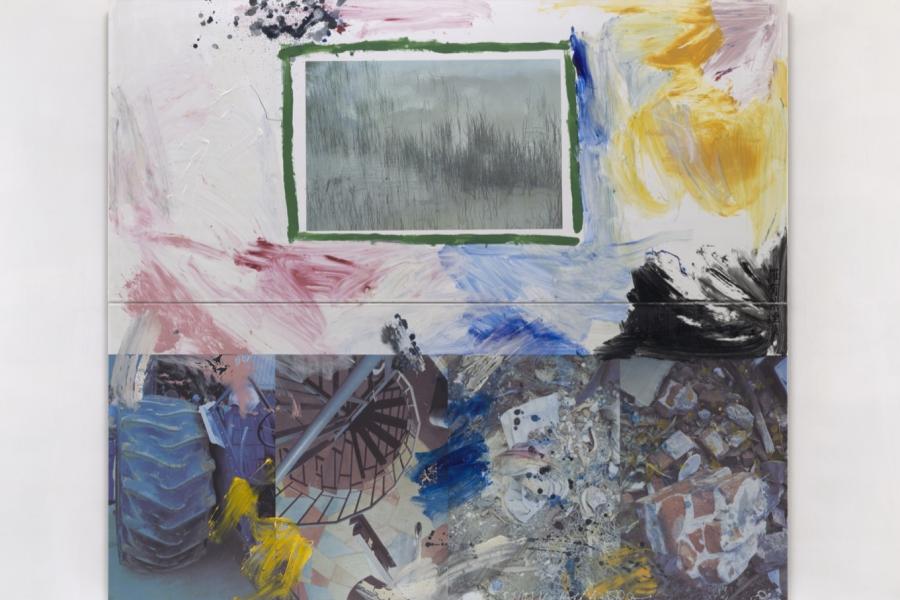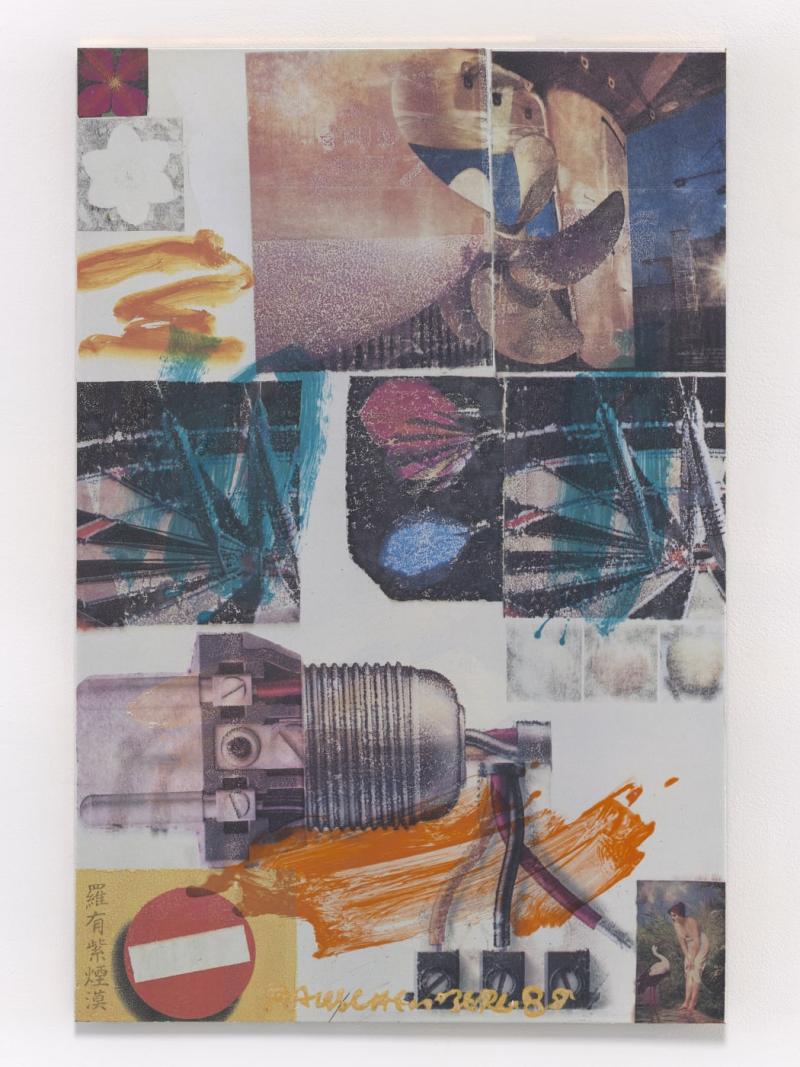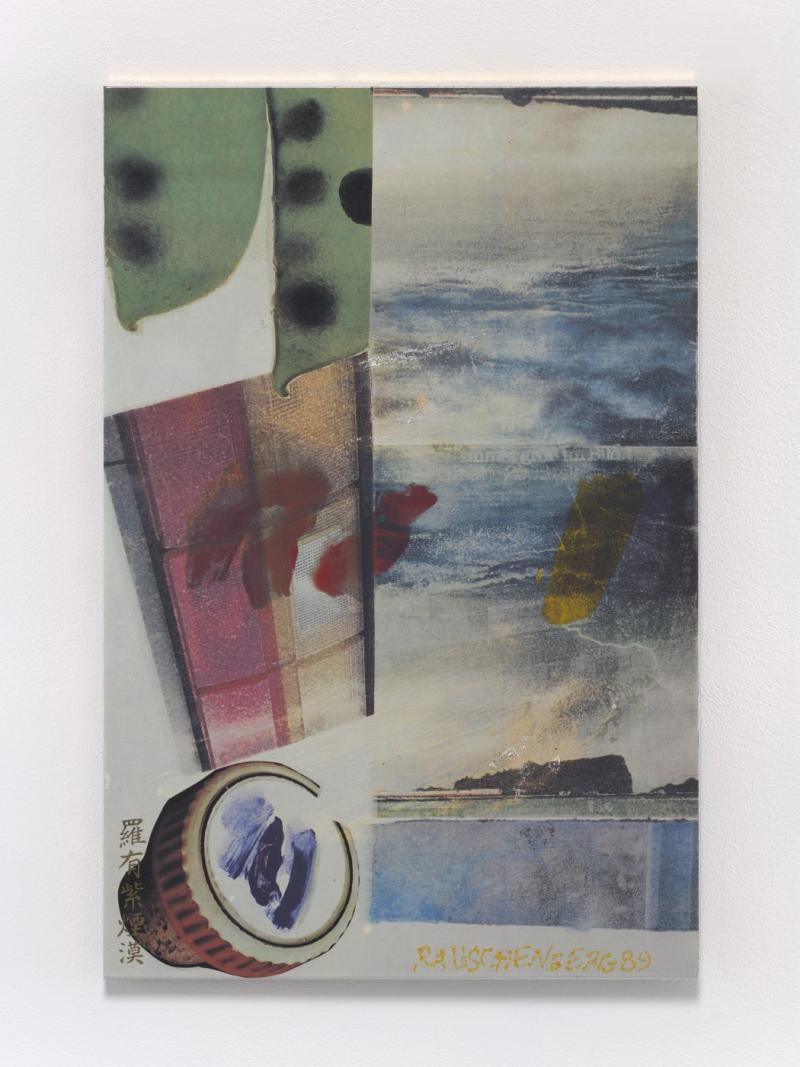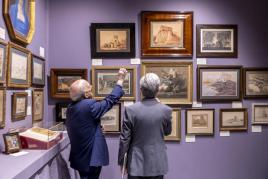Thaddaeus Ropac Paris Marais presents a selection of key works on ceramic by Robert Rauschenberg from the 1980s. Spanning works from the artist’s Japanese Clayworks series (1982/1985), as well as a further group of ceramics…
Robert Rauschenberg Japanese Clayworks
 Robert Rauschenberg, Rice Blessings (Japanese Claywork), 1985 Transfer and glaze on high-fired ceramic 180.2 x 199.8 cm (71 x 78 5/8 in) - Mit freundlicher Genehmigung von: ropac
Robert Rauschenberg, Rice Blessings (Japanese Claywork), 1985 Transfer and glaze on high-fired ceramic 180.2 x 199.8 cm (71 x 78 5/8 in) - Mit freundlicher Genehmigung von: ropacWas: Ausstellung
Wann: 06.06.2023 - 29.07.2023
Wo: Paris, Frankreich
Thaddaeus Ropac Paris Marais presents a selection of key works on ceramic by Robert Rauschenberg from the 1980s. Spanning works from the artist’s Japanese Clayworks series (1982/1985), as well as a further group of ceramics made in 1989 as a continuation of this earlier series, the exhibition highlights a formative period in the artist’s career.
Over the course of 15 years, Rauschenberg made several trips to Japan, where he collaborated with the Otsuka Ohmi Ceramics Company (OOCC) in Shigaraki to create ceramic artworks using a newly developed technique that combined ancient Japanese pottery traditions with modern innovations. He worked with local chemists to produce glazes that allowed him to silkscreen his own photographs onto transfer sheets, which were then removed from their backing, affixed to the surface of ceramic panels, and fired in the kiln. Japanese Clayworks is the first series of works that Rauschenberg made at the OOCC.
About the artistOver the course of his 60-year career, Robert Rauschenberg’s work was inspired by wide-ranging experiences, lifelong collaborations and a spirit of experimentation with new materials and techniques. Although he demurred identification with any specific movement, he has been identified as a forerunner of practically every post-war artistic development since Abstract Expressionism. His early Combines established an ongoing dialogue between painting and sculpture, between the handmade and the readymade and between the artist’s hand and the mechanically reproduced image. He revolutionised the picture plane through the inclusion of everyday objects, which he termed ‘gifts from the street’, redefining and expanding the boundaries of what could be considered an artwork.
Rauschenberg attended the Kansas City Art Institute and later the Académie Julian in Paris, but the young artist’s most profound formative experience was at the experimental Black Mountain College in North Carolina, where he enrolled in 1948 alongside fellow artist and his future wife Susan Weil. There he studied under painter and Bauhaus teacher Josef Albers and met composer John Cage and choreographer Merce Cunningham, who became long-standing friends and artistic collaborators. The trio participated in Theater Piece No. 1 (1952), a multimedia performance – now recognised as the first ‘happening’ – that incorporated poetry, music, dance and film, as well as Rauschenberg’s White Paintings (1951) suspended from the ceiling. Cage cited these as an inspiration for his composition 4’33’’ (1952), which creates a framework that prompts a heightened awareness of ambient sound.
By the end of 1953, Rauschenberg had begun integrating a litany of found materials and objects into his Red Paintings (1953–54), which evolved into his seminal Combines. Incorporating everything from a stuffed goat to street signs and a bed quilt, these works obliterated the boundary between painting and sculpture, introducing a new relationship between viewer and artwork. In 1962 he began making paintings that combined gestural brushwork with silkscreened imagery drawn from newspapers, magazines and his own photographs. Following his first retrospective, organised by the Jewish Museum, New York in 1963, Rauschenberg was awarded the International Grand Prize in Painting at the Venice Biennale in 1964.
Rauschenberg’s work throughout the subsequent decades embodied his lifelong commitment to collaboration with performers, artisans and engineers worldwide. As well as designing lighting, sets and costumes for avant-garde productions by Merce Cunningham, Trisha Brown and Paul Taylor, among others, Rauschenberg also choreographed his own performances, beginning with Pelican in 1963. He co- founded Experiments in Art and Technology (E.A.T.)
– with engineers Billy Klüver and Fred Waldhauer and artist Robert Whitman – which paired artists and engineers for collaborative projects. Together with Klüver, Rauschenberg created works like Oracle (1962–65), which incorporated transistor radio technology, and the responsive light installation Soundings (1968).
In 1970, Rauschenberg established his permanent home in Captiva, Florida, where he created several series of works focused on materiality, including the Cardboards (1971–72), wall reliefs created from discarded boxes, and the Jammers (1975–76), made from sewn fabric. His experimentation with printing techniques also continued across a range of media, including the solvent-transfer Hoarfrosts (1974–76), multimedia Spreads (1975–83) and his metal works from the 1980s and 1990s, including the Shiners (1986–93), Urban Bourbons (1988–96) and Borealis (1988–92). In addition to his own artmaking practice, Rauschenberg became a spokesperson for artists and the creative community at large. In September 1970, he founded Change, Inc., a non-profit organisation that helped artists with emergency expenses and from 1984–91, he personally funded the Rauschenberg Overseas Culture Interchange (ROCI) project. For this extensive touring programme, Rauschenberg travelled to ten countries – Mexico, Chile, Venezuela, China, Tibet, Japan, Cuba, the USSR, Germany and Malaysia – with the aim of sparking cross-cultural dialogue and understanding through the creative process.
OpeningTuesday 21 June 2022, 6—8pmWith the artist present
21 June—30 July 2022
Paris Marais7, rue Debelleyme75003 Paris, France
 Robert Rauschenberg, Port-Trait II #1, 1989 Transfer and glaze on high-fired ceramic 90 x 60 cm (35 3/8 x 23 5/8 in) - Mit freundlicher Genehmigung von: ropac / Galerie Thaddaeus Ropac Marais
Robert Rauschenberg, Port-Trait II #1, 1989 Transfer and glaze on high-fired ceramic 90 x 60 cm (35 3/8 x 23 5/8 in) - Mit freundlicher Genehmigung von: ropac / Galerie Thaddaeus Ropac Marais Robert Rauschenberg, Garden-Wise I #4, 1989 Transfer and glaze on high-fired ceramic 60 x 40 cm (23 5/8 x 15 3/4 in) - Mit freundlicher Genehmigung von: ropac / Galerie Thaddaeus Ropac Marais
Robert Rauschenberg, Garden-Wise I #4, 1989 Transfer and glaze on high-fired ceramic 60 x 40 cm (23 5/8 x 15 3/4 in) - Mit freundlicher Genehmigung von: ropac / Galerie Thaddaeus Ropac MaraisCopyright © 2024 findART.cc - All rights reserved




